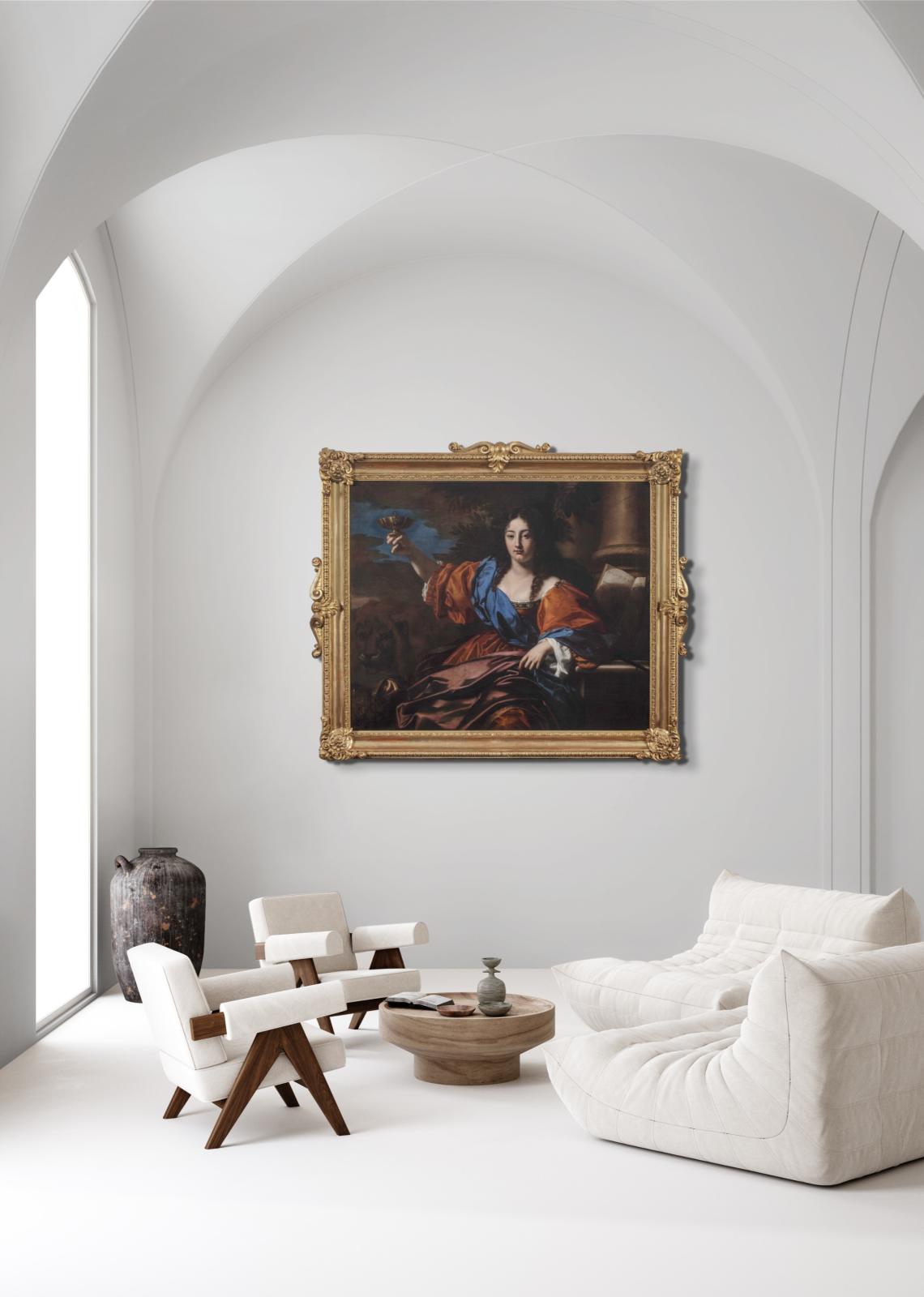artist
Nicolas Régnier initially trained in Antwerp under Abraham Janssens, a painter of Flemish origin who studied in Rome and was among the first followers of Carravaggio. As early as 1667 in Rome, Régnier saw firsthand the moody chiaroscuro and dynamic compositions of Caravaggio and his followers, which would significantly shape his artistic style. In this period Regnier also residied in Venice and Bolognia where he would expand his activities to dealing in antiques and art by others.
Régnier’s work primarily revolved around genre scenes, religious subjects, and portraits. He became known for his ability to convey human emotion and narrative depth, often employing a rich palette and dramatic lighting to enhance the mood of his compositions. His works reflect a blend of Italian Baroque techniques and Flemish traditions, creating a unique fusion that appealed to both local and international audiences.
Description
“This painting can be placed in a crucial phase in the painter’s career, between the late sixth and early seventh decade of the century: the last phase in Régnier stylist development and that of his greatest official success”, states Annick Lemoine, author of the catalogue raisonné on Régnier, who wrote in regard Circe - Régnier’s full artistic powers are unleashed. The aggressive use of tenebrism – the use of dark shadows to obscure parts of the composition along with his use of chiaroscuro – the intense contrast of light and dark, lends to a truly dramatic effect in this painting.
Circe was a goddess of Greek mythology whose name became synonymous with a witch, enchantress, sorcerer and seductress along with many others in the same vein. The best-known story of her exploits is relayed by Homer in Books X and XII of the Odyssey. Odysseus and his men reach Aeaea, the island Circe ruled, and a scouting party came across her palace which was surrounded by gardens with amazingly friendly lions, tigers and wolves. They are invited in by the goddess, given drug infused wine, and struck by her magic wand which turned them into swine. Odysseus who had remained on the ship sets out to rescue his crew and successfully convinced Circe to return his men to human form. They all remain on the island for one year, and Odysseus fathers three sons with Circe.
In Régnier’s painting Circe is presented on the steps of her palace inevitably inviting her golden chalice of poisoned wine. On her right side she is flanked by a docile lion and boar. Her magic wand rests on the stone pedestal to her left, behind which an open navigator’s handbook is discernable. Circe is richly clad in red with a blue sash, the color of royals. Her steely gaze is transfixed upon the viewer, the statuesque pose bathed in light and shadow. We are awed by her magnificence, and like Odysseus’ men, taken in by her power.
Annick Lemoine has further suggested that this painting might express “a multiplicity of meaning” She relates it to a series of 24 engravings published in Venice in 1660 by Marco Boschini in his Carta del navegar pittoresco. Figures in the engravings represent the virtues of Fortitude, Generosity, Wisdom and the goddess Flora. The first engraving in this group is a work by Régnier of an Allegory of Generosity. Stylistically comparable to this painting. Lemoine suggest, “The Allegory of Fortitude (which) may therefore be read simultaneously as an allegory of strength of mind, symbol of fortitude, and also an emblem of Venice” pointing to such as the lion as a symbol for St. Mark, the patron saint of Venice.
provenance
David Alexander Robert Lindsay, 28th Earl of Crawford and 11th Earl of Balcarres
David Alexander Robert Lindsay sale, Christie’s, London, October 11, 1946, lot 56 (as by Domenichino)
Lord Overstone, Wickham Park, Bromley
Baron di Pauli von Treuheim
Baron di Pauli von Treuheim sale, Hampel, Munich, June 24, 2005, lot 363
Old and Modern Masters, Ltd., London from whom acquired by
Luigi Koelliker, London
Luigi Koelliker sale, Sotheby’s, New York, January 29, 2009, lot 37
Robilant & Voena, London, Milan, Paris & New York, from whom sold to
Private Collection, Florida, circa 2014 until the present time
exhibitions
London, Robilant & Voena, Dutch and Flemish Caravaggesque Paintings from the Koelliker Collection, November 28 – December 19, 2007
literature
M. Pulini, Diacromie. Dialogie e Derive. Collezione Koelliker, London, 2006, unpaginated, illustrated
Annick Lemoine, “Allégorie de la Force” in Nicolas Rėgnier, Arthena, Paris, 2007, pp. 153-154, 312-313, no. 153, illustrated (in the Koelliker Collection)
Annick Lemoine, “Circe or Allegory of Fortitude” in French, Dutch and Flemish Caravaggesque Paintings from the Koelliker Collection, London, 2007, pp. 54-55, no. 15, illustrated
















